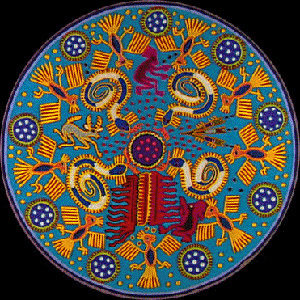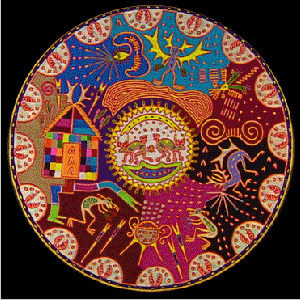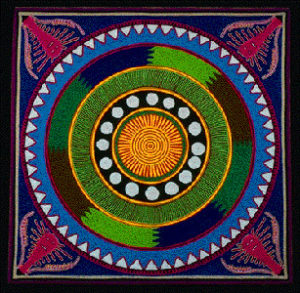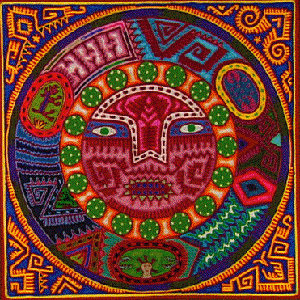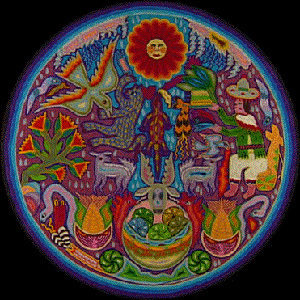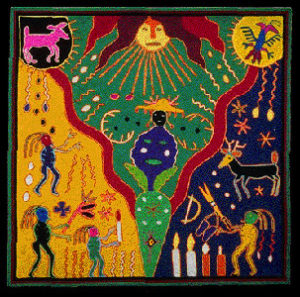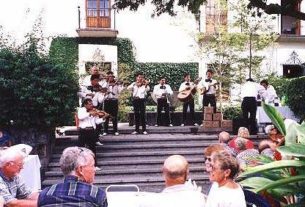Descendants of the Aztec, the Huichol number about 18,000, most of whom live in the sierra of Jalisco and Nayarit. Having withstood the Spanish Invasion, they are still striving to keep their culture alive and viable, despite the ever increasing physical and cultural encroachment of their Mexican neighbors. Peyote is a focal point for their ceremonies, and their colorful beadwork and yarnwork reflects a reverent and symbiotic relationship with nature.
The Huichol People
The Huichol people are a culture in transition as modern life encroaches upon their traditional ways. Many have migrated to cities such as Tepic and Guadalajara; others struggle with poverty, land-invasion and illness caused by pesticides in tobacco plantations where many find work as day laborers. Few outsiders are welcome in Huichol villages located in the high sierra.
- The Huichol of Jalisco and Nayarit by Robert Otey
- 20 Years visiting the Huichol A personal reflection on the current state of Huichol life by Tom Meyers
- Guadalupe and the way of the Huichol The Huichol way is the way of the Heart by Anne Paule Picker
- The Huichols: a culture in transition Viewpoints from within the culture by Susana Eger Valadez
- Traveling exhibit offers portal into the Huichol world by Erin Cassin
- The Huichol: personal reminiscences — A series by Dr. Ronald A. Barnett
Huichol Literature
Huichol proverbs offer insight into the world view of these Native American people, their ceremonial use of peyote, and their relationship with nature. Personal stories and fiction also figure in this section of Mexconnect.
- In English and Español A brief review by Glenn Welker with internal links to samples and references
- Beliefs of Mexico’s Huichol people: Responsible Ecstasy by Dr. Thomas Pinkson
- So Sings The Blue Deer by Charmayne McGee
- In a Village Far from Home by Catherine Palmer Finerty
Symbolism and Art
Although the sale of artwork is a way of survival, Huichol art is deeply symbolic, and nierikas — bead or yarnwork “votive paintings” — are petitions to the gods. Maize, peyote and deer are usually present as well as candles, arrows, serpents, scorpions and the gods’ eyes that point to the four cardinal directions. Each individual Huichol artisan develops his or her own personal style.
- Huichol art, a matter of survival by Ronald A. Barnett
- The Obsidian Butterfly: modern Huichol symbolism by Erin Cassin
- Huichol Indians: their art and symbols An introduction by Angela Corelis
- Symbolism used by the Huichols An explanation of common symbols by Angela Corelis
- The Huichol people of Mexico and their symbols: Deer, maize and peyote, the three critical symbols by Robert Otey
- Symbolic Huichol art: journeys of vision by Judy King
- Huichol art by Rita Pomade
- Traveling exhibit offers portal into Huichol world by Erin Cassin
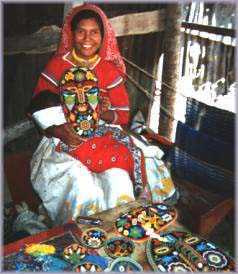
Shamanism in the Huichol Culture
The marakame, or shaman priest, plays a central role in everyday Huichol life. He is the nexus with the gods, invoked through the ceremonial use of peyote, and receives instructions from the spirit world through visions, dreams and trances.
- Shamanism and the problem of consciousness by Dr. Ronald A. Barnett
- Huichol shamanic art The influence of shamanic visions on Huichol art by Dr. Thomas Pinkson
- Comprehending shamanism in the Huichol world A brief introduction by Dr. Thomas Pinkson
- Huichol voices An accounting of a unique ritual by C. J. English
Cultural sponsors and links
These people, groups and foundations work to preserve Mexico’s Huichol heritage.
Huichol Art – with Picture galleries — a visual thrill
Beautiful photographs offer a glimpse inside the world of the Huichol and their extraordinary art. Huichol art appeals to the collector for its color, beauty and rich tribal meaning. Authentic Huichol art is available from Novica.com in association with National Geographic. Each piece is hand-crafted using traditional techniques, and many pieces are signed. A link is provided from every work of Huichol art to the bio of its creator.
- The Huichol people and their art
- Huichol artwork and how to care for it
- Huichol artwork: the ceremonial bowls by Robert Otey
- Huichol artwork:masks by Robert Otey
- Huichol artwork:celestial things by Robert Otey
The Huichol of Mexico: Cooperating Sites and Credits
This Feature Section on the Huichol, their culture, history and art, could not have been possible without the cooperation and support of a number of people and their web sites. To them we at Mexico Connect give thanks, and invite you to visit their sites.
- Native Literature Site
- The Huichol Center for Cultural Survival
- Charmayne McGee’s Site
- Dance of the Deer Foundation
- MAPS Home Page

